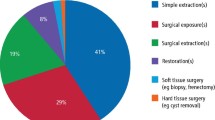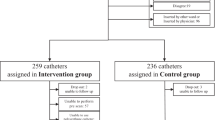Abstract
Dental surgeons regularly provide intravenous dental sedation and oral/transmucosal sedation, which involves cannulation. Cannulation is an essential skill that dental surgeons should be competent to perform, but certain patient groups may be difficult to cannulate. Ultrasound-guided peripheral intravenous cannulation is an evidence-based technique already used in radiology, emergency medicine, and anaesthesia. Ultrasound-guided peripheral intravenous cannulation has been shown to reduce complications and significantly increase the success of cannulation in patients with difficult intravenous access (DIVA); it may also be preferable in certain special care patient groups. The application of ultrasound-guided peripheral intravenous cannulation should be considered for patients with DIVA who require intravenous dental sedation or other common procedures in dental surgery that involve cannulation.
Key points
-
Discusses the potential future changes to the provision of dental sedation.
-
Discusses possible indications and contraindications of USG-PIVC for intravenous dental sedation.
-
Describes the method of USG-PIVC and current barriers to implementing USG-PIVC for intravenous dental sedation.
This is a preview of subscription content, access via your institution
Access options
Subscribe to this journal
Receive 24 print issues and online access
$259.00 per year
only $10.79 per issue
Buy this article
- Purchase on Springer Link
- Instant access to full article PDF
Prices may be subject to local taxes which are calculated during checkout




Similar content being viewed by others
References
Central Health Services Council, Standing Dental Advisory Committee, Poswillo D E. General anaesthesia, sedation and resuscitation in dentistry: report of an expert working party. London: Department of Health, 1990.
Whittle J G. The provision of primary care dental general anaesthesia and sedation in the north west region of England, 1996-1999. Br Dent J 2000; 189: 500-502.
Kramer K J. Specialty Recognition for Dental Anesthesiology. Anesth Prog 2019; 66: 59-60.
Intercollegiate Advisory Committee for Sedation in Dentistry. Standards for Conscious Sedation in the Provision of Dental Care (V1.1): Report of the Intercollegiate Advisory Committee for Sedation in Dentistry. 2020. Available at https://www.rcseng.ac.uk/-/media/files/rcs/fds/publications/standardsforconscioussedationand-accreditation/dentalsedationreportv112020.pdf (accessed November 2021).
Manley M C, Skelly A M, Hamilton A G. Dental treatment for people with challenging behaviour: general anaesthesia or sedation? Br Dent J 2000; 188:358-360.
Khan I. Falls: considerations for the dental surgeon. Br Dent J 2020; 228: 509-514.
Ford C. Cannulation in adults. Br J Nurs 2019; 28:838-841.
South Eastern Sydney Local Health District. Peripheral Intravenous Cannulation (PIVC) Insertion, Care and Removal (Adults). 2021. Available at https://www.seslhd.health.nsw.gov.au/sites/default/files/documents/SESLHDPR%20577%20Peripheral%20Intravenous%20Cannulation%20%28PIVC%29%20Insertion%2C%20Care%20and%20Removal%20%28Adults%29.pdf (accessed November 2021).
British Society for Disability and Oral Health. Guidelines for 'Clinical Holding' Skills for Dental Services for people unable to comply with routine oral healthcare. 2009. Available at: https://www.bsdh.org/documents/BSDH_Clinical_Holding_Guideline_Jan_2010.pdf (accessed December 2021).
van Loon F H J, van Hooff L W E, de Boer H D et al. The modified A-DIVA scale as a predictive tool for prospective identification of adult patients at risk of a difficult intravenous access: a multicentre validation study. J Clin Med 2019; DOI: 10.3390/jcm8020144.
Civetta G, Cortesi S, Mancardi M et al. EA-DIVA score (Enhanced Adult DIVA score): A new scale to predict difficult preoperative venous cannulation in adult surgical patients. J Vasc Access 2019; 20: 281-289.
Cooke M, Ullman A J, Ray-Barruel G, Wallis M, Corley A, Rickard C M. Not" just" an intravenous line: Consumer perspectives on peripheral intravenous cannulation (PIVC). An international cross-sectional survey of 25 countries. PloS One 2018; DOI: 10.1371/journal.pone.0193436.
Marotti J, Heger S, Tinschert J et al. Recent advances of ultrasound imaging in dentistry - a review of the literature. Oral Surg Oral Med Oral Pathol Oral Radiol 2013; 115: 819-832.
Reardon R, Heegaard B, Plummer D, Clinton J, Cook T, Tayal V. 2006. Ultrasound is a necessary skill for emergency physicians. Acad Emerg Med 2006; 13: 334-336.
Munshey F, Parra D A, McDonnell C, Matava C. Ultrasound-guided techniques for peripheral intravenous placement in children with difficult venous access. Paediatr Anaesth 2020; 30: 108-115.
Egan G, Healy D, O'Neill H, Clarke-Moloney M, Grace P A, Walsh S R. Ultrasound guidance for difficult peripheral venous access: systematic review and meta-analysis. Emerg Med J 2013; 30: 521-526.
Liu Y T, Alsaawi A, Bjornsson H M. Ultrasound-guided peripheral venous access: a systematic review of randomized-controlled trials. Eur J Emerg Med 2014; 21: 18-23.
Stolz L A, Stolz U, Howe C, Farrell I J, Adhikari S. Ultrasound-guided peripheral venous access: a meta-analysis and systematic review. J Vasc Access 2015; 16: 321-326.
Costantino T G, Parikh A K, Satz W A, Fojtik J P. Ultrasonography-guided peripheral intravenous access versus traditional approaches in patients with difficult intravenous access. Ann Emerg Med2005; 46: 456-461.
Sandhu N P S, Sidhu D S. Mid-arm approach to basilic and cephalic vein cannulation using ultrasound guidance. Br J Anaesth 2004; 93: 292-294.
Armson A M, Moynihan R, Stafford N, Jacobs C. Ultrasound-guided cannulation for medical students. Clin Teach 2021; 18: 295-300.
Blair J A. Ultrasound guided peripheral venous cannulation: A useful skill for foundation doctors? J Intens Care Soc 2021; DOI: 10.1177/17511437211003500.
Stuckey C, Curtis M P. Development of a nurse-led ultrasound-guided peripheral intravenous programme. J Vasc Nurs 2019; 37: 246-249.
Vitto M J, Myers M, Vitto C M, Evans D P. Perceived difficulty and success rate of standard versus ultrasound-guided peripheral intravenous cannulation in a novice study group: A randomized crossover trial. J Ultrasound Med 2016; 35: 895-898.
Jenssen C, Brkljacic B, Hocke M et al. EFSUMB guidelines on interventional ultrasound (INVUS), Part VI - Ultrasoundguided vascular interventions. Ultraschall Med 2016; 37: 473-476.
Joint Formulary Committee. BNF 82 (British National Formulary): September 2021 - March 2022. London: Pharmaceutical Press, 2021.
Franklin W J, Strickman N E, Hall R J. Stent deployment for peripheral venous stenosis as a result of radiation therapy. Catheter Cardiovasc Interv 2003; 59: 60-62.
Jakes A D, Twelves C. Breast cancer-related lymphoedema and venepuncture: a review and evidence-based recommendations. Breast Cancer Res Treat 2015; 154: 455-461.
Thorn C, Nickels L C. Ultrasound-Guided Peripheral Intravenous Access. In Ganti L (ed) Atlas of Emergency Medicine Procedures. pp 13-15. New York: Springer, 2016.
Gallieni M, Pittiruti M, Biffi R. Vascular access in oncology patients. CA Cancer J Clin 2008; 58: 323-346.
Eves J, Cai P, Latham R et al. A randomised clinical trial of ultrasound guided cannulation of difficult fistulae for dialysis access. J Vasc Access 2021; 22: 635-641.
Vinograd A M, Chen A E, Woodford A L et al. Ultrasonographic guidance to improve first-attempt success in children with predicted difficult intravenous access in the emergency department: a randomized controlled trial. Ann Emerg Med 2019; 74: 19-27.
The Royal College of Radiologists. Focused ultrasound training standards. 2012. Available at https://www.rcr.ac.uk/system/files/publication/field_publication_files/BFCR%2812%2918_focused_training.pdf (accessed June 2021).
McLoughlin R. Ultrasound: Skills of Ultrasound-guided Vascular Access. 2021. Available from https://www.rcemlearning.org/modules/ultrasound-skills-of-ultrasound-guided-vascular-access/ (accessed March 2022).
Blanco P. Ultrasound-guided peripheral venous cannulation in critically ill patients: a practical guideline. Ultrasound J 2019; DOI: 10.1186/s13089-019-0144-5.
Im Suk J, Walker F O, Cartwright M S. Ultrasonography of peripheral nerves. Curr Neurol Neurosci Rep 2013; DOI: 10.1007/s11910-012-0328-x.
Blessing M. Ultrasound Probe Selection, Knobology and Optimization of Image Quality. In Li J, Ming-Der Chow R, Vadivelu N, Kaye A D (eds) Ultrasound Fundamentals: An Evidence-Based Guide for Medical Practitioners. pp 17-24. Switzerland: Springer Nature, 2021.
Interanest. Peripheral venous cannulation. 2018. Available at https://www.interanest.org/ (accessed June 2021).
Clemmesen L, Knudsen L, Sloth E, Bendtsen T. Dynamic needle tip positioning-ultrasound guidance for peripheral vascular access. A randomized, controlled and blinded study in phantoms performed by ultrasound novices. Ultraschall Med 2012; DOI: 10.1055/s-0032-1312824.
Forsyth J M, Shalan, A, Thompson A R. Venous access made easy. 2nd ed. London: Taylor & Francis, 2019.
Baribeau Y, Sharkey A, Chaudhary O et al. Hand-held point of care ultrasound probes-the new generation of POCUS. J Cardiothoracic Vasc Anaesth 2020; 34: 3139-3145.
Gibson L E, Bittner E A, Chang M G. Handheld ultrasound devices: An emerging technology to reduce viral spread during the Covid-19 pandemic. Am J Infect Control 2020; 48: 968-969.
Leipheimer J M, Balter M L, Chen A I et al. First-in-human evaluation of a hand-held automated venipuncture device for rapid venous blood draws. Technology (Singap World Sci) 2019; 7: 98-107.
Author information
Authors and Affiliations
Corresponding author
Ethics declarations
The author declares no conflict of interest.
Supplementary Information
Rights and permissions
About this article
Cite this article
Khan, I. Ultrasound-guided peripheral intravenous cannulation for patients requiring dental surgery under intravenous dental sedation. Br Dent J 232, 441–448 (2022). https://doi.org/10.1038/s41415-022-4133-x
Received:
Accepted:
Published:
Issue Date:
DOI: https://doi.org/10.1038/s41415-022-4133-x



